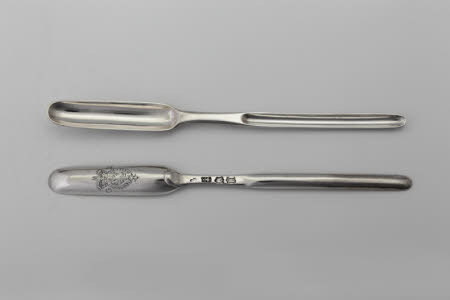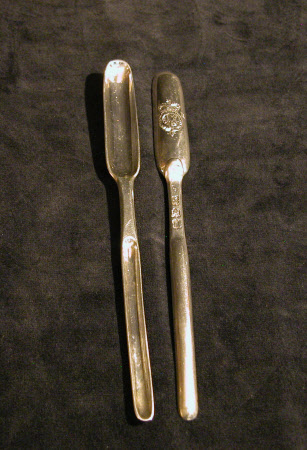Marrow spoon
Paul Callard
Category
Silver
Date
1755 - 1756
Materials
Sterling silver
Measurements
2.0 cm (Width); 21.6 cm (Length)
Place of origin
London
Order this imageCollection
Ickworth, Suffolk
NT 852099.35
Summary
Marrow spoon, sterling silver, by Paul Callard, London, 1755/6. One of two. The spoon is forged from a single rod of silver and is double ended with two concave recessions, one long and thin and the other wider and shorter. There is no ornamentation apart from a single drop at the junction of the stem with the back of the large scoop. On the back of the large scoop is engraved the quartered arms of the Hanoverian monarchs (pre-1801) within the Garter and beneath an imperial crown flanked by the initials GR.
Full description
Silver marrow spoons, as these implements were commonly known until the mid nineteenth century and at Ickworth even beyond that,[1] probably came into being in the late seventeenth century. They were used to extract the marrow from the inside of bones, which was considered a delicacy and continued to be widely valued until the early twentieth century.[2] Lord Bristol acquired three with his ambassadorial plate but only two of them remained amongst the future 1st Marquess’s silver in 1826.[3] The other one probably found its way to Ireland with the Earl-Bishop and passed with his property there. The spoons would have been laid on the table by dishes containing meat on the bone, with the carving knives and forks. Given their date they must have been taken from stock in 1758. Paul Callard made most of Lord Bristol’s ambassadorial flatware and seems to have had a brief spell as a rival to Ebenezer Coker in the second half of the 1750s. James Rothwell, Decorative Arts Curator January 2021 [Adapted from James Rothwell, Silver for Entertaining: The Ickworth Collection, London 2017, cat. 70, p. 154.] Notes: [1] Suffolk Record Office, HA 507/9/21, List of silver etc offered in lieu of death duties, c.1951, pp. 6 & 16. [2] G. Bernard Hughes, Small Antique Silverware, 1957, pp. 199-200. [3] Suffolk Record Office, 941/75/2, Bristol Plate List 1826-7, f. 3.
Provenance
Jewel Office; allocated to George Hervey, 2nd Earl of Bristol (1721-75) as Ambassador to Madrid 1758; discharged to Lord Bristol 9th April, 1759; by descent to the 4th Marquess of Bristol (1863-1951); accepted by the Treasury in lieu of death duties in 1956 and transferred to the National Trust.
Credit line
Ickworth, the Bristol Collection (National Trust)
Marks and inscriptions
Stem: Hallmarks: date letter ‘u’, leopard’s head, lion passant and maker’s mark ‘PC’ beneath two mullets and above a fleur-de-lis (Arthur Grimwade, London Goldsmiths 1697-1837, 1990, no. 2150) for Paul Callard.
Makers and roles
Paul Callard, goldsmith

